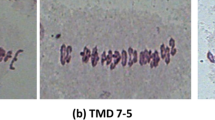Abstract
Triticale introgressive lines were developed by incorporating diploid wheat (Triticum monococcum [TM16]) genes into the hexaploid triticale genotype LT522/6. The synthetic allotetraploidT. monococcum cereale (AmAmRR) was used as a bridging form to introduce the genes. A group of 43 introgressive lines, parental stocks and a check cultivar were inoculated at the seedling stage (in the greenhouse) and at the adult plant stage (in the field) with four pathotypes ofPuccinia striiformis f. sp.tritici to determine if the stripe rust resistance was derived from TM16 and to analyze the expression of the diploid wheat gene(s) at the hexaploid level. At the seedling stage, 14 triticale introgressive lines expressed resistance to some of the used pathotypes, showing introduction of a genetic material from theT. monococcum genome. Among them, 7 lines were resistant to all four stripe rust pathotypes applied at this stage. In the field, adult plant resistance and percentage of infected leaf area were scored and transformed into the coefficient of infection. Plant response to stripe rust was compatible at these two developmental stages with a high statistical probability showing the genetic dependence on the same genetic background. Also observed was a full concordance of the adult plant resistance to stripe rust with previously assessed resistance to leaf rust, as well as the highly significant linkage of the resistance to the both diseases at the seedling stage in the set of the tested introgression lines. This result strongly suggests thatT. monococcum genes responsible for these characters are located in proximity.
Similar content being viewed by others
References
Arseniuk E, 1996. Triticale diseases — a review. In: Guedes-Pinto H. et al. (eds.), Triticale: Today and Tomorrow. The Netherlands, Kluwer Acad. Publishers: 499–525.
Bayles RA, Flath K, Hovmeller MS, de Vallavieille-Pope C, 2000. Breakdown of the Yr17 resistance to yellow rust of wheat in Northern Europe. Agronomie 20: 805–811.
Hovmøller MS, 2001. Disease severity and pathotype dynamics ofPuccinia striiformis f. sp.tritici in Denmark Plant Pathology 50: 181–108.
Johnson R, 1981. Durable disease resistance. In: Jenkyn IF, Plumb RT (eds.), Strategies for Control of Cereal Diseases. Blackwell, Oxford: 55–63.
Johnson R, Stubbs RW, Fuchs E, Chamberlain NH, 1972. Nomenclature for physiologic races ofPuccinia striiformis infecting wheat. Trans Br Mycol Soc. 58: 475–480.
Ma H, Singh RP, Mujeeb-Kazi A, 1997. Resistance to stripe rust in durum wheats, A-genome diploids, and their amphiploids. Euphytica 94: 279–286.
McIntosh RA, Singh SJ, 1986. Rusts — Real and potential problems for triticale. Proc Int Triticale Symp., Sydney, Occasional Publ No. 24: 199–207.
McIntosh RA, Yamazaki Y, Devos KM, et al. 2003. Catalogue of Gene Symbols for Wheat. Proc 10th Int Wheat Genetics Symp., Paestum, Rome, Italy: Vol. 4.
Roelfs AP, Singh RP, Saari EE, 1992. Rust Disease of Wheat: Concepts and methods of disease management. Mexico, D.F., CIMMYT: 1–81.
Saari E, Varughese G, Abdalla OA, 1986. Triticale diseases: Distribution and importance. Proc Int Triticale Symp, Sydney, Occasional Publ 24: 208–231.
Singh RP, Saari EE, 1991. Biotic stresses in triticale. Proc 2nd Int Triticale Symp, Mexico D.F., CIMMYT: 171–181.
Sodkiewicz W, 1997. Synthesis of wheat-rye allotetraploids in the process ofT. monococcum L. (2n=14) genes introgression into hexaploid triticale (2n=6x=42) (xTriticosecale Wittmack). IPG PAS (ed.), series Treatises and Monographs v. 7, Poznan, (in Polish): 1–109.
Sodkiewicz W, Sodkiewicz T, Makarska E, 2002. Introgression ofTriticum monococcum genes as a method of widening of hexaploid triticale biodiversity. In: Marè C, Faccioli P, Stanca AM., From Biodiversity to Genomics: Breeding Strategies for Small Grain Cereals in the Third Millenium. EUCARPIA — Cereal Section Meeting (21–25 November, 2002), Salsomaggiore, Italy: 147–149.
Sodkiewicz W, Strzembicka A, 2004. Application ofTriticum monococcum for the improvement of triticale resistance to leaf rust (Puccinia triticina). Plant Breeding 123: 39–42.
Sodkiewicz W, Strzembicka A, Apolinarska B, 2008. Chromosomal location in triticale of leaf rust resistance genes introduced fromTriticum monococcum. Plant Breeding 127: 364–367.
Woźniak-Strzembicka A, 2003. Wheat yellow rust in Poland: virulence frequencies in pathogen population Biul IHAR 230: 119–126 (in Polish).
Wang F, Pasquini M, 1999. Virulence of wheat stripe rust in Italy. Cereal Rusts and Powdery Mildews Bulletin 27: 1–8.
Author information
Authors and Affiliations
Corresponding author
Rights and permissions
About this article
Cite this article
Sodkiewicz, W., Strzembicka, A., Sodkiewicz, T. et al. Response to stripe rust (Puccinia striiformis Westend. f. sp.tritici) and its coincidence with leaf rust resistance in hexaploid introgressive triticale lines withTriticum monococcum genes. J Appl Genet 50, 205–211 (2009). https://doi.org/10.1007/BF03195674
Received:
Accepted:
Issue Date:
DOI: https://doi.org/10.1007/BF03195674




